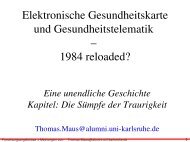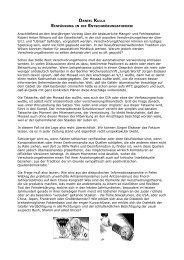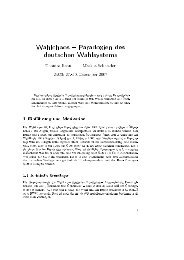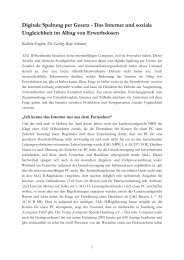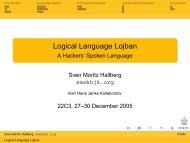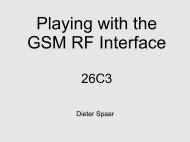Complete Hard Disk Encryption Using FreeBSD's GEOM Framework
Complete Hard Disk Encryption Using FreeBSD's GEOM Framework
Complete Hard Disk Encryption Using FreeBSD's GEOM Framework
Create successful ePaper yourself
Turn your PDF publications into a flip-book with our unique Google optimized e-Paper software.
This list is by no means exhaustive and every user thinking about using complete hard<br />
disk encryption is strongly encouraged to carefully evaluate its benefits and drawbacks.<br />
4.3 GBDE vs. GELI<br />
FreeBSD provides two tools for encrypting partitions, GBDE and GELI. Both can be used<br />
to make complete hard disk encryption work. If GBDE is chosen, the memory disk<br />
approach must be used, as GBDE does not allow the kernel to mount an encrypted<br />
partition as the root filesystem. The advantage is that it is possible to use a lockfile in<br />
addition to a passphrase. This makes for a more robust security model and should<br />
compensate for the administrative “overhead” caused by the memory disk.<br />
GELI not only makes it possible to use a memory disk too, it also allows the user to<br />
choose from different cryptographic algorithms and key lengths. In addition to that it<br />
also offers support for dedicated cryptographic hardware devices and of course<br />
eliminates the need for a memory disk by being able to directly mount the encrypted<br />
boot partition. The drawback of mounting the root directly from an encrypted partition<br />
is that GELI so far does not allow for a keyfile to be used and therefore the security of the<br />
encrypted data depends solely on the passphrase chosen.<br />
Looking at the features of the two tools, it may seem as though GELI would be the<br />
better choice in any situation. It should be noted, however, that GBDE has been around<br />
for much longer than GELI and therefore is more likely to have received more testing and<br />
review.<br />
5 Conclusion<br />
Mobile devices are intended to be used anywhere and anytime. As these devices get<br />
increasingly sophisticated, they allow the users to store massive amounts of data – a lot<br />
of which may often be sensitive. Encrypting individual files simply does not scale and on<br />
top of that does nothing to prevent the data from leaking to other places. Partitionbased<br />
encryption scales much better but still, a lot of information can be compiled from<br />
unencrypted sources such as system log files, temporary working copies of opened files<br />
or the swap partition. In addition to that, both schemes do nothing to protect the<br />
operating system or the applications from being compromised.<br />
In order to defend against this kind of attack, it is necessary to encrypt the operating<br />
system and the applications as well and boot the core parts such as the kernel from a<br />
removable medium. Since the boot code must be stored unencrypted in order to be<br />
loaded, it must be kept on a medium that can easily be looked after.<br />
FreeBSD provides two tools capable of encrypting disks: GBDE and GELI. <strong>Complete</strong><br />
hard disk encryption can be accomplished by using either a memory disk as the root<br />
filesystem and then mount the encrypted hard disk in a subdirectory or by directly<br />
mounting the encrypted hard disk as the root filesystem.<br />
The first approach can be done with both GBDE and GELI and has the advantage<br />
that a lockfile or keyfile can be used in addition to the passphrase, therefore providing<br />
more robust security. The second approach omits the memory disk and therefore saves<br />
some administrative work. It works only with GELI, however, and does not allow for a<br />
keyfile to be used – therefore requiring a tradeoff between better usability/maintainability<br />
and security.<br />
23



